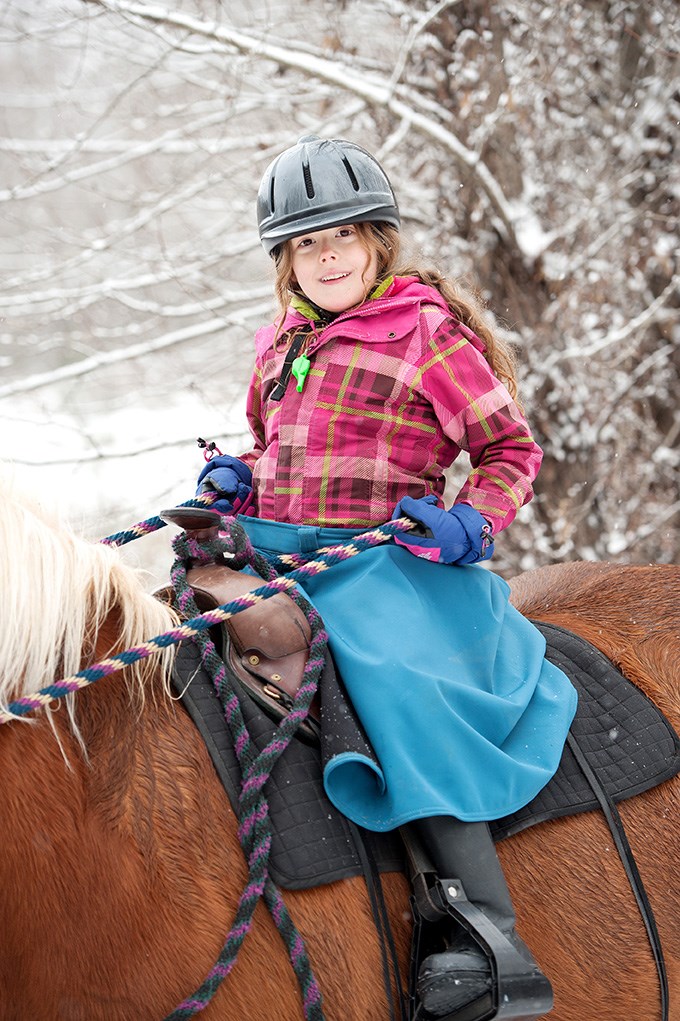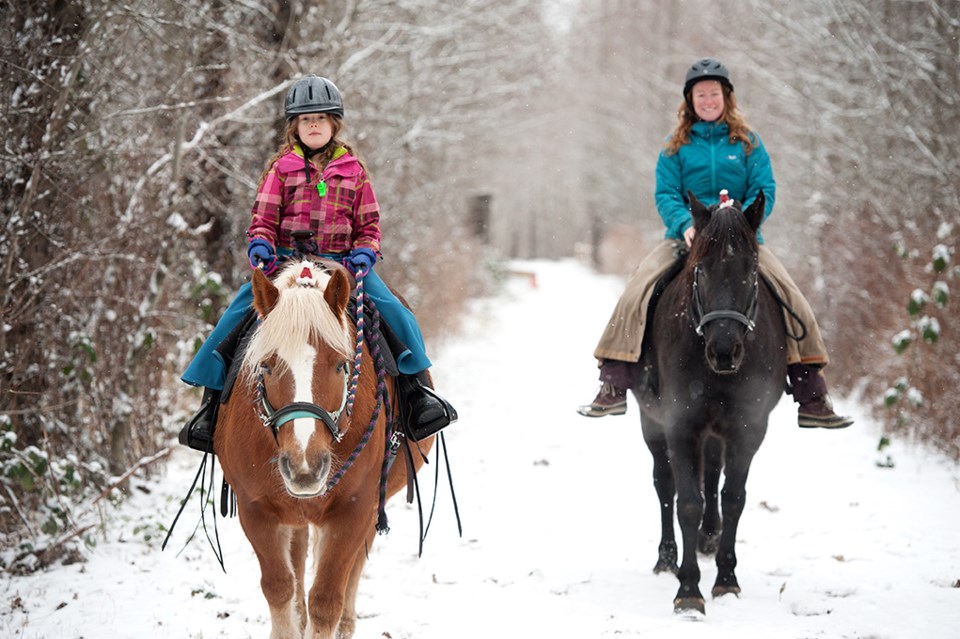Crystal Tress never dreamed her twelve-year-old son would start horseback riding and love it. Not only that, she says he’s “changed” since connecting with a horse after beginning lessons in October.
“He really has opened up from this quiet, timid boy to this person who really likes talking with people,” she explains. “He is a totally different child.”
An avid animal lover, her son wasn’t attracted to “organized sports.” Tress remembers when they tried soccer, he wanted to go home the moment it started to rain. It wasn’t until she saw him “happy” on a horse in the November storm showers, she recognized his passion and determination.
“It teaches him responsibility,” she says, adding he learns to connect and care for the huge creature. You don’t need to own a horse to get on one, Tress says. She also credits her son’s growth to coach Nichole Murray, whom she calls “amazing.”
Murray is the vice president of the Squamish Valley Equestrian Association, the local club that just celebrated its 65th year. Murray joined three years ago and rides the trails all winter, provided the ground doesn’t freeze over, making it unsafe for the horses. She owns two horses that are kept on leased land.
Murray teaches horsemanship lessons and also runs an equine-assisted learning program. She describes the latter as “life-coaching where the horse is part of the team.” It’s geared toward personal development and teaches children and adults qualities like trust, responsibility, communication, skills of perception and leadership.
As a prey animal, horses are safe in a herd. So you have to be a strong leader, or you’re in trouble, she explains.
You need to be fair, communicate clearly and be kind, she added. “You have to find the right way of describing something.” The large animals are sensitive to subtle cues. “As soon as you can find clear communication, they’re your partner. They’re part of the herd.”

Riding helps a lot with issues like anxiety, says Murray, who spends the winter offering private lessons. She enjoys watching children go from nervous to empowered — one of her students saves allowance money to pay for weekly lessons. “The level of confidence it can bring is really incredible,” she says.
Lessons are run out of one of the SVEA’s two outdoor arenas — leased from the District and open to those associated with the club. Murray used to frequent Howe Sound Stables, which allowed drop-ins for a fee, but they recently closed. Rapid land development makes leasing land tougher. It’s difficult and costly to keep a horse, with fees ranging from $500-$1,200 per horse a month, Murray says, adding an indoor facility would help.
The dream is to see Squamish look more like Powell River, she continues. With a similar population and demographics, the city owns land with an indoor arena and attached stables. “It’s a multi-use facility for the community,” Murray explains, adding it runs clinics, workshops, rents out to user groups and does 70 therapeutic program riding sessions a week.
Stephanie Golder is a member of the SVEA and uses the outdoor arena to teach a program that is separate from the association with approximately 10 therapeutic riding sessions a week. With a background of riding for 26 years and years working for a riding society for the disabled in Alberta, Golder’s taught therapeutic riding locally for the last two years.
She also hopes for an indoor facility. “We don’t have a centre here in Squamish and when I moved [here] I was desperate to continue my teaching,” she says. “The nearest place was an hour and a half away.”
Golder was teaching over 14 children four days a week until the facility on Loggers Lane closed, making winter sessions difficult this year. She still uses the SVEA outdoor arenas but sees fewer clients. There’s a wait list for summer lessons, she noted.
“People come to therapeutic riding for different reasons,” she says, Open to anybody with a clinical diagnosis, she sees a range of clients from children with autism to riders with physical disabilities or emotional challenges.
Clients results include increased mobility in limbs and speech patterns, strengthening life skills like responsibility, staying safe in challenging situations or controlling anger, Golder notes. “My feedback from clients, therapists and doctors is that it’s so important to be able to ride once a week,” she says. “Horses in Squamish doesn’t just have to be about access to horse riding.”
There aren’t many year-round facilities in Canada, but just a cover to keep out of the rain would make a difference, Golder says. “If it’s windy or loud, they can’t hear me over the rain. Even things as simple as frozen hands make it difficult to sign,” she explains.
The winter also presents a real challenge for those who competitively ride. “Unless you’re a trail rider, you can’t compete on frozen ground,” says Kim Lawrence, a dressage rider and president of the SVEA.
Losing the indoor arena on Loggers Lane was a blow to the equestrian community, she adds. Without a facility, it’s difficult to run anything horse related during the winter.
“People lay off their horses all winter, which isn’t good for them because they lose conditioning,” Lawrence says. “It’s like a triathlete not training between seasons.” You can’t trot or canter a horse on frozen ground because you’ll injure them, she adds.
Though not every member of the SVEA participates in horse shows, many ride hunter or dressage style. The training is meticulous and costly but worthwhile: Lawrence loves the technical element and competing against herself.
She hopes to see a Squamish with an indoor facility with multi-use purposes, noting the District is doing an audit of leased lands. But there’s little land appropriate to build a facility and what exists is too expensive, Lawrence says, adding there are two barns in town with indoor arenas, but they’re full. “Unless you can board your horse, you have to ride outside,” she says. “We are slowly getting squeezed out.”
Horses are a part of Squamish’s history, and Lawrence wants to see them part of the future. “Before there was anything, there were horses,” she says.
**Please note, this story has been corrected since it was first published. Originally, Stephanie Golder's name was misspelled.




